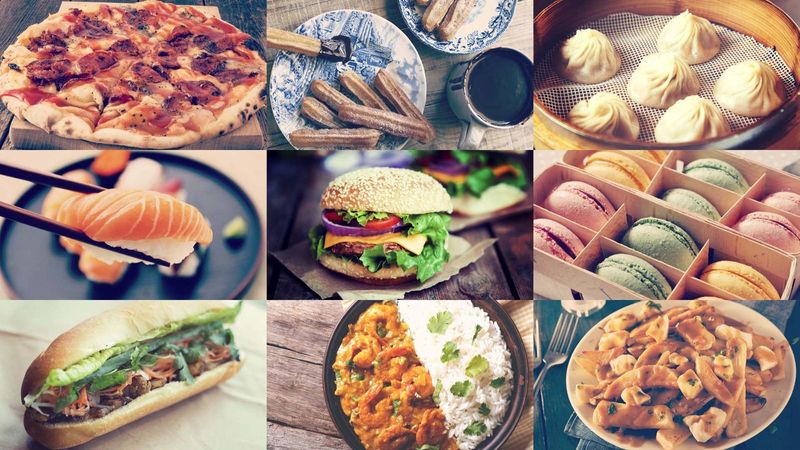Food Travel 101
Angela Hassassian
Sep 04, 2018 - 8 min read

Maybe you’re on the hunt for tangy tamarind juice from the terraces of Stone Town, or looking to sip some golden Tokaji aszú wine (“wine of Kings”) in the Tokaj, Hungary, or maybe you want to let your taste buds experience the diverse flavors of cheese from Switzerland’s Alpine areas like Canton Uri. You might be on a palatable adventure in Thailand, seeking different levels of spicy ranging from Thai or Farang (tourist). Perhaps you’ve booked an Eat Portugal tour, taking you through some of the best tastes that Lisbon has to offer, including the new Mercado da Ribeira. If any of these sound relatable, you are a part of what is now known as Food Tourism.
Food travel is not particularly new, but it certainly takes up a good chunk of the travel market. There are some variations on the definition of food tourism, but for many, it’s as simple as being “the pursuit and enjoyment of unique and memorable food and drink experiences, both far and near,” as defined in the book Culinary Tourism: A Tasty Economic Proposition. In reality, all of us are food travelers at heart, by the simple act of going to a neighboring town or city that we rarely visit just to eat at a specific restaurant! Research from 2016 Food Travel Monitor claims that 93% of travelers can now be considered food travelers. That’s no small number!
Foodie: Who Me?
Their studies regarded any traveler who had participated in a food or beverage experience other than dining out at some time in the past 12 months as being a food traveler. This includes anything from going on a food tour, going shopping in a local grocery or gourmet store, or visiting a cooking school. Taking tours of food/beverage factories or participating in wine tasting events or beer festivals also fall under activities that food travelers take part in. Going off the beaten path to uncover hidden gems and boutiques which offer specialty food and beverage items is part of what food travelers and explorers do. So if you are going into the hidden streets in New York to get a rainbow bagel from the Bagel Store, you are in fact a food traveler.
So what does this mean for travel industry professionals? Well, according to World Food Travel, travelers spend about 25% of their travel budget on food and beverages, and sometimes even as much as 35%, depending on how expensive their destinations are or if they are self-proclaimed avid foodies. Things have evolved beyond expensive Instagram worthy food, and like everything else, have shifted to authentic culinary experiences. It’s no longer about dining at fancy restaurants. It’s more about visiting local farms, taking cooking classes in a local’s house, or attending popular food or drink festivals. As with anything travel related nowadays, the focus is on the authentic experience.
Understanding The Market
The definition of adventure travel is also changing accordingly to include anything where you are “experiencing a new culture.” Intrepid Travel has noticed a 20% increase in bookings this year for its Real Food Adventure tours which offer cooking classes, wine tastings and local market visits. Meanwhile, there are tour companies worldwide which focus on local produce and “made-in-” tours. It seems, more than ever, there are people who are even willing to go so far as to plan their entire vacations around food, choosing destinations based on their culinary offerings. As previously mentioned about solo traveling, eating food alone can be a bit daunting. That’s why many websites like EatWith and Meal Sharing have cropped up over recent years, offering solo travelers the option to eat with a group and learn about their destination in the process.
Travelers are also becoming much more mindful of their economic impact on society, leading to more conscious decisions when it comes to how they spend their money. This includes opting for eco-friendly tours, buying organic produce at local markets and finding ways to spend their money which will be more beneficial for the local economy and community. We’ve touched upon how Millennials tend to support brands whose values align with theirs, which is why when they travel, they are more likely to choose small boutique hotels over big chains, and small/medium businesses over large corporations or foreign investment companies.
What To Look Out For
Eating local foods is associated with higher quality, a cultural connection and in some cases, the opportunity to build a relationship with locals. Some people are more health conscious and are interested in finding healthy and nutritious food, even, and possibly especially, when they are on the go. Others have serious dietary restrictions and need to carefully navigate appropriately. The world was shocked when Italy’s vegetarian population nearly doubled between the years of 2011 and 2016, a growth of 94.4% in 5 years! Consumers are also more supportive of alternative packaging, as they are more than willing to drink using steel straws instead of plastic ones, or drinking wine from a can or box if it means helping the environment. Industry professionals should certainly take notes.
What are the benefits to be had in jumping on the bandwagon? Japan is an excellent example of a foodie travelers paradise, where they offer unique cuisine, have a landscape filled with traditional marketplaces, and several options for different and creatively themed dining experiences. What does this result in? For one, it helps to promote local culture, by offering a unique appetizing experience, you set your market position apart. This also boosts the likelihood of repeat visitation, not to mention a higher average amount of money spent during said stay. This, in turn, leads to an overall boost to the local economy. The more unique and authentic the experience, the more likely you’ll receive media coverage and a competitive advantage. When used wisely, a boost in food tourism can result in an increased interest in your destination as a whole!
Tasty Travel Industry Tips
So if you are part of a tourist agency or association, consider marketing culinary-focused tourism as one of your priorities. Get culinary influencers to visit and promote your cuisine. Start making those foodie-focused itineraries and create tours that cater to their culinary interests. Tour operators, cash in and promote those local food markets and festivals as part of your offers! Speak to your local wine, beer and rum distilleries and create custom tours and tasting opportunities. Incorporate authentic food as a part of your adventure tours. Make sure to create ample opportunities for your consumers to also get the word out and share their experiences.
Hotels, resorts and restaurants should also be taking note by adding local dishes to their menus. Partner up with some local produce growers, and use it as part of your marketing strategy. Perhaps consider offering cooking classes either on the property or in partnership with local chefs. Offer your guests the opportunity to be part of a “Dine Around” program, allowing them to use discounts or credits at a number of local and authentic restaurants in the area. Another option is to become a vendor at festivals and events. Share your stories about how you started your business, and share the passion that you have for food with your guests.
In the end, food is more than just about how something tastes. It’s about getting to know an integral piece of culture. It is part of the travel experience as a whole. Traditional cuisine is generally passed down from one generation to the next and is possibly the most authentic form of expressing cultural identity. 360Stories understands the role that food plays in travel, which is why they encourage travelers to share their culinary experiences and stories on their platform as well. On 360Stories you can find everything from reviews of fancy restaurants in Paris to tips on where to get some of the best affordable street foods in Taiwan and beyond. The food industry is something that travel industry professionals should not ignore!


